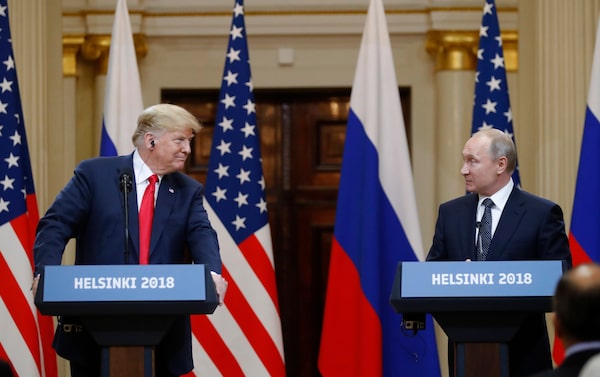
July 16, 2018: U.S. President Donald Trump and Russian President Vladimir Putin arrive for a press conference after their meeting in Helsinki.Alexander Zemlianichenko/The Associated Press
Helsinki: The highlights
- “I don’t see any reason" to believe that Russians hacked the 2016 U.S. election, which American intelligence agencies insist they did, President Donald Trump said Monday after a one-on-one meeting in Helsinki with his Russian counterpart, Vladimir Putin, who continued to deny Moscow’s meddling.
- The two leaders spent more than two hours in private, longer than the expected 90 minutes, after which they met with their top advisers. Standing beside Mr. Putin at a news conference, Mr. Trump said U.S.-Russian relations have never been worse, but he believed that “changed as of about four hours ago.”
- Monday’s meeting, the final stop on a chaotic European tour, was condemned in advance by members of Congress after the U.S. indictment last week of 12 Russian military intelligence officers accused of hacking Democrats in the 2016 presidential election. Those politicians, including top Republicans, were outraged by Mr. Trump taking Russia's side: “I have said a number of times, I’ll say it again: The Russians are not our friends,” Senate Majority Leader Mitch McConnell said. “And I entirely believe the assessment of our intelligence community.”
- During the meeting, Britain's Prime Minister Theresa May – who had been Mr. Trump's host in a U.K. visit last week – rose in Parliament to condemn Russia, saying its leadership was trying to undermine Western values and that its spy service was behind the use of a lethal nerve agent on British soil. She said she "welcomes" the Trump-Putin summit but wants to see Moscow change its ways.
What was Trump and Putin’s summit actually about?
“The time has come to talk thoroughly about bilateral relations as well as various hot spots in the world,” Russian President Vladimir Putin said Monday ahead of his private meeting with his U.S. counterpart, Donald Trump, in Helsinki. For Russia, those hot spots include Syria, whose years-long civil war evolved into a proxy conflict between Washington, Moscow and their respective Middle Eastern allies; Crimea, whose status as Russian territory Moscow sees as non-negotiable; Ukraine, whose eastern regions have seen years of conflict after pro-Russian rebels waged wars of independence in 2014; and Eastern Europe, which NATO has been working to fortify against future Russian aggression.

Helsinki hot spots
Russian President Vladimir Putin and U.S. President Donald Trump held their first official summit in Helsinki on July 16.
Arms control: Both Russia and U.S. have yet to begin discussions on what to do when New Strategic Arms Reduction Treaty (New Start) expires in 2021.
Military build-up: U.S. plans permanent U.S. military base in Poland. Russia could respond with air base in Belarus
Kaliningrad: Russia has deployed nuclear-capable Iskander missiles in violation of Intermediate-range Nuclear Forces (INF) Treaty
Ukraine: Trump has refused to rule out recognizing Russia’s annexation of Crimea
NATO
countries
Helsinki
Russian
troops
stationed
Moscow
RUSSIA
Belarus
Poland
Ukraine
Crimea
Georgia
Syria
IRAN
CANADA
Hamadan Airbase
Used by Russia to
conduct raids in Syria
U.S.
Syria: Russia’s goal is to prevent regime change in Syria where it has its only Mediterranean naval base. U.S. wants Iranian troops to leave
Georgia: With 20% of its territory under Russian occupation since 2008, South Ossetia and Abkhazia have become Russian military bases
THE GLOBE AND MAIL, Sources: GRAPHIC NEWS
(Foreign Policy; Stratfor; Time; Reuters)

Helsinki hot spots
Russian President Vladimir Putin and U.S. President Donald Trump held their first official summit in Helsinki on July 16.
Arms control: Both Russia and U.S. have yet to begin discussions on what to do when New Strategic Arms Reduction Treaty (New Start) expires in 2021.
Military build-up: U.S. plans permanent U.S. military base in Poland. Russia could respond with air base in Belarus
Kaliningrad: Russia has deployed nuclear-capable Iskander missiles in violation of Intermediate-range Nuclear Forces (INF) Treaty
Ukraine: Trump has refused to rule out recognizing Russia’s annexation of Crimea
NATO
countries
Helsinki
Russian
troops
stationed
Moscow
RUSSIA
Belarus
Poland
Ukraine
Crimea
Georgia
Syria
IRAN
CANADA
Hamadan Airbase
Used by Russia to
conduct raids in Syria
U.S.
Syria: Russia’s goal is to prevent regime change in Syria where it has its only Mediterranean naval base. U.S. wants Iranian troops to leave
Georgia: With 20% of its territory under Russian occupation since 2008, South Ossetia and Abkhazia have become Russian military bases
THE GLOBE AND MAIL, Sources: GRAPHIC NEWS
(Foreign Policy; Stratfor; Time; Reuters)

Helsinki hot spots
Russian President Vladimir Putin and U.S. President Donald Trump held their first official summit in Helsinki on July 16.
Arms control: Both Russia and U.S. have yet to begin discussions on what to do when New Strategic Arms Reduction Treaty (New Start) expires in 2021.
Military build-up: U.S. plans permanent U.S. military base in Poland. Russia could respond with air base in Belarus
Ukraine: Trump has refused to rule out recognizing Russia’s annexation of Crimea
Kaliningrad: Russia has deployed nuclear-capable Iskander missiles in violation of Intermediate-range Nuclear Forces (INF) Treaty
Helsinki
RUSSIA
NATO
countries
Moscow
Belarus
Poland
Ukraine
Russian
troops
stationed
Crimea
Georgia
Syria
IRAN
CANADA
Hamadan Airbase
Used by Russia to
conduct raids in Syria
U.S.
Syria: Russia’s goal is to prevent regime change in Syria where it has its only Mediterranean naval base. U.S. wants Iranian troops to leave
Georgia: With 20% of its territory under Russian occupation since 2008, South Ossetia and Abkhazia have become Russian military bases
THE GLOBE AND MAIL, Sources: GRAPHIC NEWS (Foreign Policy;
Stratfor; Time; Reuters)
At their joint news conference, the two leaders elaborated on what they had talked about, but still left many questions unanswered. Here’s what they said:
- The 2016 U.S. election: Mr. Trump said he directly addressed Russia's interference in the presidential election, but did not condemn Moscow's conduct publicly. He said he “spent a great deal of time” talking about the issue and that Mr. Putin feels strongly about it and “has an interesting idea,” though he did not say what that idea was. At their joint news conference, Mr. Putin again denied Russian involvement: “I had to repeat that the Russian state never interfered, and does not plan to interfere in internal American electoral process.”
- Nuclear proliferation: Mr. Putin praised Mr. Trump for efforts to resolve nuclear tensions with North Korea. “It’s good that the gradual resolution of the problem of the Korean Peninsula has begun," he said. Mr. Putin also said he and Mr. Trump agreed to continue detailed discussions on arms-control issues, and that Russia and the U.S. should discuss a possible extension of the 2010 New START nuclear arms reduction treaty and the implementation of the 1987 Intermediate Nuclear Forces Treaty.
But the biggest issue of the summit seems to be whether Mr. Trump and Mr. Putin will be friends or foes. Mr. Trump has strenuously insisted that improved relations with Russia would benefit the United States. But much of the appeal of the Finland meeting was simply to have the summit itself and to bolster ties between Washington and Moscow and between Mr. Putin and Mr. Trump, who places his personal rapport with foreign leaders near the heart of his foreign policy. “We have not been getting along well for the last number of years,” Mr. Trump said as the meeting began. “But I think we will end up having an extraordinary relationship. … I really think the world wants to see us get along.”
For Mr. Putin, sitting down with Mr. Trump offers some more concrete goals. The Russian Prseident wants the U.S. and its allies to lift sanctions, pull back NATO forces deployed near Russia’s borders and restore business as usual with Moscow. In the longer run, he hopes to persuade the U.S. to acknowledge Moscow’s influence over its former Soviet neighbours and, more broadly, recognize Russia as a global player whose interests must be taken into account.
But back in the United States, the timing and context of the Trump-Putin summit has taken a more ominous meaning because of the investigation of the Trump campaign’s ties to Russia. Days before the summit, an indictment against 12 members of Russia’s GRU military intelligence service laid out the most detailed explanation yet of how Russian hackers stole data about U.S. voters, illegally accessed Democratic National Convention servers and stole and disseminated documents meant to embarrass Hillary Clinton, Mr. Trump’s rival for the presidency. With midterm elections coming up in November, U.S. intelligence officials are watching closely for more Russian schemes to influence the outcome.
What you missed before Helsinki: A recap
Monday, July 9
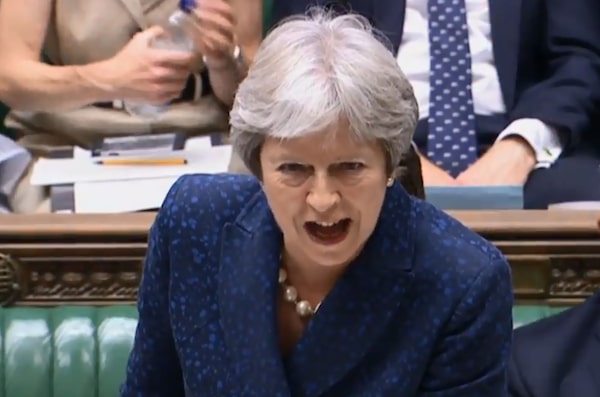
July 9: Britain's Prime Minister Theresa May gives a statement to the House of Commons on Brexit.HO/Getty Images
London - Days before playing host to Mr. Trump, British Prime Minister Theresa May was fighting for her political future in a feud with her cabinet ministers over Brexit strategy. On Sunday and Monday, three ministers quit: First David Davis, who had been in charge of talks to take Britain out of the European Union; then Steve Baker, a junior cabinet minister in the Brexit department; then the biggest of them all, foreign secretary Boris Johnson, who is considered a major rival to Ms. May for the party leadership. Their departures heightened friction between members of the Conservative Party cabinet who want a complete break with the EU and those who want to keep some economic ties, like the customs union.
Doug Saunders: Theresa May has driven Britain into a dead end
Tom Rachman: A fresh disaster: How Brexit is diverting Britain
Ottawa - Canadian Prime Minister Justin Trudeau set out from Ottawa for Riga, the Latvian capital. Canadian soldiers are in the country as part of Operation Reassurance, a NATO mission to deter Russian interference in the Baltic region.
More reading: For many in Latvia’s Russified east, Canada’s ‘Operation Reassurance’ is anything but
Tuesday, July 10
Canada's Prime Minister Justin Trudeau visits NATO troops at Latvia’s Adazi military base.INTS KALNINS/Reuters
Latvia - After arriving in Latvia late Monday night, Mr. Trudeau met Tuesday with Prime Minister Maris Kucinskis, then announced that Canada’s NATO commitment in the country would be extended to March, 2023. He also said Canada would increase its deployment from 455 soldiers to 540. Later in the day, Mr. Trudeau met with Latvian President Raimonds Vejonis, visited a military base in Adazi and attended a candlelight vigil at a Latvian memorial to fallen soldiers.
Washington - Mr. Trump, preparing to set off for Brussels, fired off a series of tweets accusing NATO members of shirking their responsibilities to pay into the organization and making the U.S. bear the disproportionate cost.
Wednesday, July 11
July 11, 2018: U.S. President Donald Trump holds a breakfast meeting with NATO Secretary-General Jens Stoltenberg, left, at the military alliance’s summit in Brussels.Kevin Lamarque/Reuters
Brussels - Mr. Trump’s morning in the Belgian capital began with a breakfast meeting with NATO’s Secretary-General Jens Stoltenberg, which got unusually tense when he accused Germany of being in Russia’s thrall. “I have to say, I think it’s very sad when Germany makes a massive oil and gas deal with Russia where we’re supposed to be guarding against Russia,” Mr. Trump said, apparently referring to the Nord Stream 2 pipeline from Russia to Germany’s Baltic coast. “We’re supposed to protect you against Russia but they’re paying billions of dollars to Russia and I think that’s very inappropriate.” Mr. Stoltenberg pushed back, stressing that NATO members have been able to work together despite their differences.

Sanctions could block
Nord Stream 2 pipeline
The United States has threatened sanctions
against companies in Austria, France, Germany
and the Nether-lands that are involved in the
Nord Stream 2 natural gas pipeline linking Russia
and Germany
Nord Stream 2 would deliver extra
55bcm of gas directly to Germany
RUSSIA
UK
GER.
POLAND
UKRAINE
FRANCE
SPAIN
ITALY
TURKEY
Main Russian gas export pipelines
500km
EU member states
Critics fear pipeline would increase Europe’s reliance on
Russian gas. Countries such as Ukraine also stand to lose
lucrative transit fees
EU NATURAL GAS CONSUMPTION BY YEAR
Billion cubic metres (bcm)
Imported from Russia
Other
500
400
300
200
100
0
2005
‘06
‘07
‘08
‘09
‘10
‘11
‘12
‘13
‘14
‘15
‘16
‘17
the globe and mail, Sources: graphic news;
Bloomberg, Stratfor

Sanctions could block
Nord Stream 2 pipeline
The United States has threatened sanctions against
companies in Austria, France, Germany and the Nether-
lands that are involved in the Nord Stream 2 natural gas
pipeline linking Russia and Germany
Nord Stream 2 would deliver extra
55bcm of gas directly to Germany
RUSSIA
UK
GER.
POLAND
UKRAINE
FRANCE
SPAIN
ITALY
TURKEY
Main Russian gas export pipelines
500km
EU member states
Critics fear pipeline would increase Europe’s reliance on
Russian gas. Countries such as Ukraine also stand to lose
lucrative transit fees
EU NATURAL GAS CONSUMPTION BY YEAR
Billion cubic metres (bcm)
Imported from Russia
Other
500
400
300
200
100
0
2005
‘06
‘07
‘08
‘09
‘10
‘11
‘12
‘13
‘14
‘15
‘16
‘17
the globe and mail, Sources: graphic news;
Bloomberg, Stratfor

Sanctions could block Nord Stream 2 pipeline
The United States has threatened sanctions against companies in
Austria, France, Germany and the Netherlands that are involved in the
Nord Stream 2 natural gas pipeline linking Russia and Germany
Nord Stream 2 would deliver extra
55bcm of gas directly to Germany
RUSSIA
UK
POLAND
GERMANY
UKRAINE
FRANCE
SPAIN
ITALY
Main Russian gas
export pipelines
TURKEY
500km
EU member states
Critics fear pipeline would increase Europe’s reliance on Russian gas.
Countries such as Ukraine also stand to lose lucrative transit fees
EU NATURAL GAS CONSUMPTION BY YEAR
Billion cubic metres (bcm)
Imported from Russia
Other
500
400
300
200
100
0
2005
‘06
‘07
‘08
‘09
‘10
‘11
‘12
‘13
‘14
‘15
‘16
‘17
the globe and mail, Sources: graphic news; Bloomberg, Stratfor
As she arrived at NATO headquarters, German Chancellor Angela Merkel rejected Mr. Trump’s remarks about being a “captive” to Russia, reminding him that, having been born in pre-Cold War East Germany, and she knew what it was like to see at least part of her country under Moscow’s thumb. Later, she and Mr. Trump met face to face and discussed investment, trade, defence and migration issues. Afterward, Mr. Trump described it as a “great meeting.” adding: “We have a tremendous relationship with Germany.”
Canada is projected to spend just over 1.2 per cent of gross domestic product on defence this year, well below the 2-per cent target. But in Brussels, Mr. Trudeau said that his country plays a prominent role in NATO missions and is investing heavily in new military equipment. Before Mr. Trump’s breakfast meeting, Mr. Trudeau announced Canada would take the lead of NATO’s new military training mission in Iraq, and is prepared to offer up to 250 troops. “We have to build that democracy and strengthen it,” Mr. Trudeau said at a German Marshall Fund event on the sidelines of the summit. “Those sorts of tangible elements are at the heart of what NATO stands for. You can try and be a bean counter and look at exactly how much this and how much money that, but the fundamental question is: is what you’re doing actually making a difference?”
Later Wednesday, Mr. Trudeau met Mr. Trump on the summit’s margins for an informal chat about trade, their first face-to-face meeting since June’s G7 summit in Quebec. The conversation was focused on the North American free-trade agreement and the recent election of a new Mexican president, a spokeswoman for Mr. Trudeau said.
Thursday, July 12
Brussels - Mr. Trump’s second day at the NATO summit featured similar rhetoric to the first. In a series of tweets, he singled out Germany, the second-biggest contributor to NATO’s common budget, saying it and other wealthy nations needed to pay more.
Presidents have been trying unsuccessfully for years to get Germany and other rich NATO Nations to pay more toward their protection from Russia. They pay only a fraction of their cost. The U.S. pays tens of Billions of Dollars too much to subsidize Europe, and loses Big on Trade!
— Donald J. Trump (@realDonaldTrump) July 12, 2018
....On top of it all, Germany just started paying Russia, the country they want protection from, Billions of Dollars for their Energy needs coming out of a new pipeline from Russia. Not acceptable! All NATO Nations must meet their 2% commitment, and that must ultimately go to 4%!
— Donald J. Trump (@realDonaldTrump) July 12, 2018
NATO leaders held an emergency meeting to address Mr. Trump’s criticisms. Afterward, Mr. Trump said they had caved to his demands and made significant pleges to increase spending, though he did not specify which countries had committed to what. “I told people that I would be very unhappy if they didn’t up their commitments,” an ebullient president told reporters at a news conference. “I let them know that I was extremely unhappy,” he said, but added that the talks had ended on the best of terms: “It all came together at the end. It was a little tough for a little while.”
But France’s President Emmanuel Macron disputed whether Mr. Trump talked as tough as he says he did. “President Trump never at any moment, either in public or in private, threatened to withdraw from NATO,” Mr. Macron said at a news conference. Mr. Macron also disputed Mr. Trump’s claim that NATO allies have agreed to boost defence spending beyond 2 per cent of GDP.
Mr. Trudeau, for his part, said Canada was already working toward increasing its military spending through a 10-year plan announced in June, 2017.
More reading: Trump, allies end NATO summit at odds over spending commitments
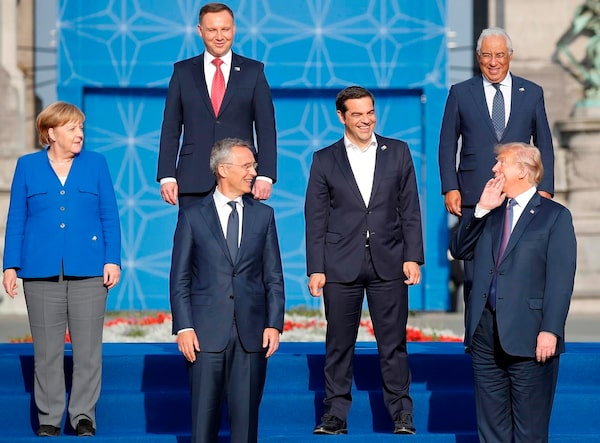
President Donald Trump, lower right, leans back to talk to other NATO leaders at a group photo in Brussels. From left are German Chancellor Angela Merkel, Polish President Andrzeji Duda, NATO Secretary-General Jens Stoltenberg, Greek Prime Minister Alexis Tsipras and Portuguese Prime Minister Antonio Costa.Pablo Martinez Monsivais/The Canadian Press
London - Mr. Trump’s arrival in London was quickly overshadowed by things he said back in Brussels to The Sun, a British tabloid newspaper. In an interview published Thursday, Mr. Trump took direct aim at his British hosts:
- He accused Ms. May of ruining her country's Brexit plan, saying her version of separation from the EU "is a much different deal than the one the people voted on” in the 2016 Brexit referendum.
- He said Ms. May's Brexit strategy would endanger future U.S.-U.K. trade deals. “If they do a deal like that, we would be dealing with the European Union instead of dealing with the U.K., so it will probably kill the deal.”
- He praised Boris Johnson, who had resigned as foreign secretary days earlier: “I think he would be a great prime minister. I think he’s got what it takes. I think he is a great representative for your country.”
- He blamed recent terrorist attacks in London on Mayor Sadiq Khan, who is a Muslim. The president claimed Europe is “losing its culture” because of immigration from the Middle East and Africa.
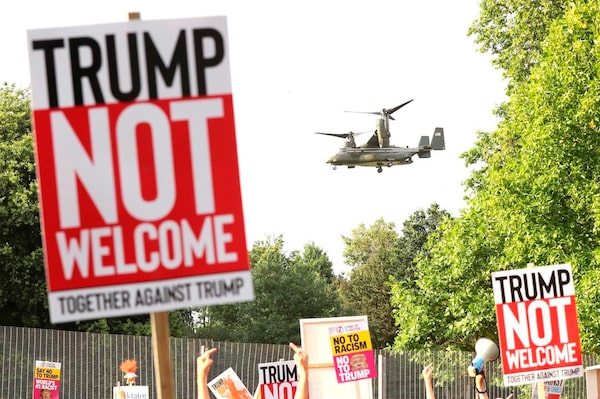
A helicopter leaves the grounds of the U.S. ambassador’s residence in Regent's Park, London.Gareth Fuller/The Canadian Press
Britons vented anger at Mr. Trump at his helicopter flight on Marine One leaving from the ambassador’s residence. Demonstrators jeered and banged pots and pans, and another group of protesters lined roads near the palace. Some of their signs read “Dump Trump,” ”Lock Him Up” and “There Will Be Hell Toupee.” Police worked overtime, their days off cancelled.
The U.S. President’s first official function in Britain was an evening reception at Blenheim Palace, birthplace of Winston Churchill. The outdoor arrival ceremony at Blenheim — Mr. Trump wore a tuxedo and first lady Melania Trump a butter-yellow, chiffon, off-the-shoulder gown — was a grand affair marked by a military band in bearskin hats, hundreds of business leaders in black tie and gorgeous setting sunlight.
Friday, July 13
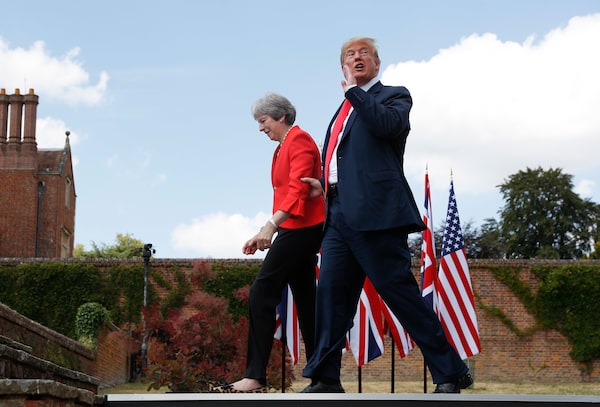
July 13: Mr. Trump responds to a reporter's shouted questions as he walks with Ms. May at Chequers, in Buckinghamshire.Pablo Martinez Monsivais/The Associated Press
London - After lambasting his British host the day before, Mr. Trump started his Friday with Ms. May, watching a military demonstration at the Royal Military Academy Sandhurst. The event was closed to the media.
The two later travelled to Chequers, the prime minister’s country retreat, where the two met for one-on-one talks followed by a news conference. There, Mr. Trump walked back his comments to The Sun: “This incredible woman right here is doing a fantastic job, a great job,” he said. “Unfortunately, there was a story that was done which was generally fine but it didn’t put in what I said about the prime minister and I said a tremendous thing. It’s called fake news.” Ms. May praised the strength of the U.S.-U.K. bond, but in a gentle rebuke to Mr. Trump, she said “it is all of our responsibility to ensure that transatlantic unity endures.”
In London and dozens of other cities across Britain, protesters rallied to speak out against the President’s visit. Hundreds crowded in Parliament Square under a balloon depicting Mr. Trump as a screaming baby. Some 16 balloon minders in yellow vests identifying themselves as “babysitters” minded lead lines to the balloon as the curious gawked and took pictures.
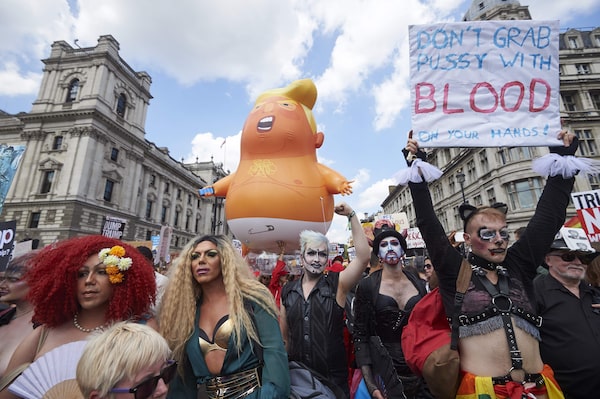
London: Drag queens and protesters take part in a rally.NIKLAS HALLEN/Getty Images
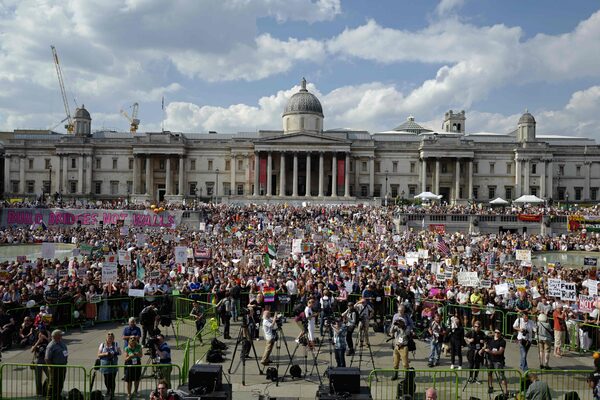
Trafalgar Square is filled with protesters holding up placards.TOLGA AKMEN/Getty Images
Washington - Around the time Mr. Trump went to Windsor Castle to meet the Queen, an announcement back in Washington cast a shadow over the upcoming Helsinki summit: The Justice Department announced indictments against 12 Russian military intelligence officers, charging them with hacking the computer networks of Democratic candidate Hillary Clinton in 2016. Deputy Attorney-General Rod Rosenstein said he briefed Mr. Trump earlier in the week about the indictment.
Hours before the announcement, Mr. Trump described the investigation by special counsel Robert Mueller as a “rigged witch hunt,” saying it was hurting the U.S.-Russian relationship.
Saturday-Sunday, July 14-15
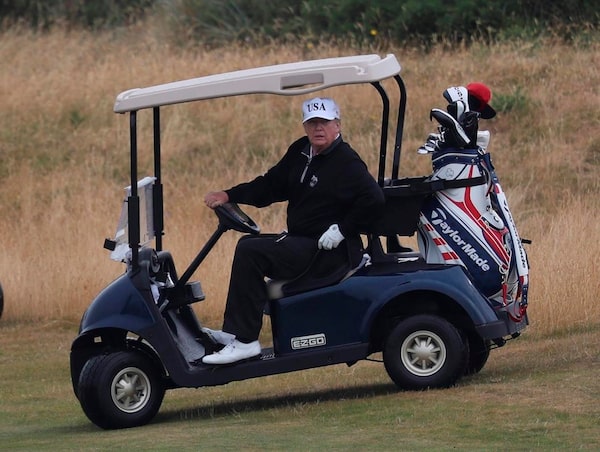
July 15: Mr. Trump drives a golf buggy on his golf course in Turnberry, Scotland.Andrew Milligan/The Canadian Press
Scotland - Mr. Trump spent the weekend at the Turnberry resort in Scotland, his mother’s homeland. Dozens of protesters rallied outside his resorts on Saturday, while thousands marched through the capital of Edinburgh in opposition.
Mr. Trump’s relationship with Scotland is a complicated one: Ever since he ventured into Scotland a dozen years ago, he has been losing money and battling with longtime residents, wind farms and politicians. Anger at Trump has been especially hot in Aberdeenshire, where Mr. Trump’s plans have been mired in controversy from the day he bought the land in 2006. Neighbors have accused Trump of harassment and bullying to get them to sell land (Here’s an in-depth report from The Globe’s Mark MacKinnon on how those controversies played out.)
Ahead of his Monday summit in Helsinki, Mr. Trump gave an interview with CBS News in which he named the EU as one of the global enemies of the United States: “I think the European Union is a foe, what they do to us in trade,” he said, adding that “you wouldn’t think of the European Union, but they’re a foe.” He said that Russia is a foe “in certain respects” and that China is a foe “economically ... but that doesn’t mean they are bad. It doesn’t mean anything. It means that they are competitive.”
London - Ms. May gave an interview of her own in which she revealed that Mr. Trump had advised her to get Britain out of the EU by suing them, a suggestion she rejected. “He told me I should sue the EU. Not go into negotiation, sue them,” she told the BBC, adding with a laugh: “Actually, no. We’re going into negotiations with them.”
Helsinki - Mr. Trump arrived in the Finnish capital late Sunday from Scotland. Several dozen supporters, many waving American flags and sporting “Make America Great Again” caps, cheered him as he neared the posh waterfront hotel where he was staying. Several were from the True Finn anti-immigration party, and said they wanted to make a show of support in a country where many people have criticized his policies.
Monday, July 16
July 16: Mr. Trump Russia's President Vladimir Putin shake hands as they meet in Helsinki.KEVIN LAMARQUE/Reuters
Helsinki - Mr. Trump started his day with some eyebrow-raising tweets about the NATO summit (he said NATO leaders called him “thanking me for helping to bring them together”), Mr. Mueller’s investigation (which he again called a “Rigged Witch Hunt”) and U.S.-Russian relations (which he said had “NEVER been worse thanks to many years of U.S. foolishness and stupidity and now, the Rigged Witch Hunt!”).
Later in the morning, he and Ms. Trump met Finnish President President Sauli Niinistö at Helsinki’s Mäntyniemi Residence, where Mr. Putin was due to arrive for the one-on-one talks. They would have to wait for him a while longer than planned: Mr. Putin, who is habitually tardy in meetings with world leaders, arrived in Helsinki 30 minutes late.
Once the leaders were finally together, they shook hands in a room of the palace adorned by U.S. and Russian flags. Their private meeting in the palace’s Gothic Hall, originally scheduled for 90 minutes, went on for more than two hours before the two joined their top advisers for a luncheon.
The two then emerged for a joint news conference, where Mr. Trump said they had discussed the 2016 election-meddling, North Korea and defence issues. Mr. Trump was invited by reporters to offer any criticism of Russia but he repeatedly declined. Asked if he believed U.S. intelligence agencies, which concluded that Russia interfered in the 2016 election to help him win, he said he was not convinced. “President Putin was extremely strong and powerful in his denial today,” Mr. Trump said. Asked whether he had wanted Mr. Trump to win the election and had instructed officials to help him, Mr. Putin said “Yes I did,” although he denied any interference, saying the allegations were “complete nonsense.”
United States - Mr. Trump’s defence of Russia was met with shock and disappointment by politicians of both parties. “There is no moral equivalence between the United States and Russia, which remains hostile to our most basic values and ideals,” Republican House Leader Paul Ryan said.
Republican Senator Lyndsay Graham said Mr. Trump’s performance would send a message of “weakness” to Moscow:
Missed opportunity by President Trump to firmly hold Russia accountable for 2016 meddling and deliver a strong warning regarding future elections.
— Lindsey Graham (@LindseyGrahamSC) July 16, 2018
This answer by President Trump will be seen by Russia as a sign of weakness and create far more problems than it solves. (1/3)
Chuck Schumer, the Democrats’ minority leader in the Senate, challenged Republicans to confront the President directly by increasing sanctions on Russia and requesting testimony about the summit from administration officials. “We need our Republican colleagues to stand up for the good of this country,” he said.
What is NATO? A primer
How it started: NATO is a military alliance forged in the years after the Second World War, amid fears that the postwar Soviet Union would move the Iron Curtain further into Europe. Canada, the United States and nine European nations were NATO’s founding members, while the USSR set up a rival defence alliance called the Warsaw Pact. After the Soviet Union collapsed, NATO’s membership grew considerably, and it now has 29 member states.

NATO EXPANSION
A look at the spread of the North Atlantic Treaty
Organization (NATO) after the demise of the
USSR in 1989.
NATO country
members
in 1989
Former USSR
USSR’s partners
in the Warsaw Pact
Moscow
Current NATO
members (2015)
Russia
Russian partners in
the Collective Security
Treaty Organization
Moscow
Ukraine called for full NATO membership in 2014
reuters, Source: NATO

NATO EXPANSION
A look at the spread of the North Atlantic Treaty Organ-
ization (NATO) after the demise of the USSR in 1989.
NATO country
members
in 1989
Former USSR
USSR’s partners
in the Warsaw Pact
Moscow
Current NATO
members (2015)
Russia
Russian partners in the
Collective Security
Treaty Organization
Moscow
Ukraine called for full NATO membership in 2014
reuters, Source: NATO

NATO EXPANSION
A look at the spread of the North Atlantic Treaty Organization (NATO) after the
demise of the USSR in 1989.
NATO country
members in 1989
Former USSR
USSR’s partners
in the Warsaw Pact
Moscow
Current NATO
members (2015)
Russia
Russian partners in the
Collective Security Treaty
Organization
Moscow
Ukraine called for full NATO membership in 2014
reuters, Source: NATO
Tensions with Russia: In 2014, tensions between NATO and Moscow reached a new post-Cold War high because of a Russian-backed separatist uprising in eastern Ukraine, followed by the annexation of Crimea from Ukraine. Western nations saw the pattern of Russian expansionism extending to regions of Georgia, and potentially the Baltic states of Lithuania, Latvia and Estonia. NATO began a mission to defend those countries called Operation Reassurance, which Canadian troops are still a part of.
Tensions with Trump: When NATO’s conflict with Russia first escalated, then U.S. president Barack Obama was strongly critical of his Russian counterpart’s expansionist aims. But during and shortly after the 2016 U.S. election, Donald Trump was more dismissive of NATO: He said the alliance was “obsolete,” accused other NATO members of not paying their fair share and suggested that renewing ties with Russia was a good idea. He walked back the “obsolete” comment in 2017, and his administration tried to tread lightly on the Russia file amid investigations of Moscow’s ties to the Trump presidential campaign. But last month, Mr. Trump disrupted the first day of the Group of Seven summit in Quebec by suggesting that Russia should be readmitted. Soon after, Washington and Moscow struck a deal to bring Mr. Trump and Mr. Putin together for talks in Helsinki on July 16. What Mr. Trump will say in Brussels about Russia is anyone’s guess, but it has the potential to sow further division in the group.
Tensions over money: Mr. Trump’s criticism of NATO has also centred on money. Member countries agreed in 2014 to spend 2 per cent of their GDP on defence within a decade. The U.S. far exceeds that target, but most countries haven’t met it yet, and Canada is near the bottom of the list in terms of spending by GDP. Last summer, Defence Minister Harjit Sajjan announced a $62.3-billion, 20-year spending plan that would raise defence spending to 1.4 per cent of GDP by 2024-25.

NATO shortfalls in
defence budgets
Twenty-four of NATO’s 29 members are
forecast to fall below thealliance’s long-term
target of spending 2% of GDP on defence
NATO DEFENCE SPENDING, 2018 est. (% of GDP)
U.S.
3.50
Greece
2.27
Estonia
2.14
Britain
2.10
Latvia
2.00
Poland
1.98
Lithuania
1.96
Romania
1.93
France
1.81
Turkey
1.68
Target met
Norway
1.61
Montenegro
1.58
Target not met
Bulgaria*
1.56
Portugal
1.36
Netherlands
1.35
Croatia
1.30
Germany
1.24
Canada
1.23
Denmark
1.21
NATO spending
target of
2% of GDP
Slovakia
1.20
Albania
1.19
Italy
1.15
Czech Rep.
1.11
Hungary
1.08
Slovenia
1.01
Spain
0.93
*Does not include
pensions
Belgium
0.93
Luxem.
0.55
United States
Canada
$706.1bn
$21.6
Britain
(second
largest
after
U.S.)
NATO
total
spending
$61.5bn
US$1,013bn
Europe
(total)
$285.7bn
Data based on 2010 prices
and exchange rates
NATO member Iceland has
no standing military force
THE GLOBE AND MAIL, SOURCE: graphic news;
NATO estimates

NATO shortfalls in defence budgets
Twenty-four of NATO’s 29 members are forecast to fall
below thealliance’s long-term target of spending 2%
of GDP on defence
NATO DEFENCE SPENDING, 2018 est. (percentage of GDP)
U.S.
3.50
Greece
2.27
Estonia
2.14
Britain
2.10
Latvia
2.00
Poland
1.98
Lithuania
1.96
Romania
1.93
France
1.81
Turkey
1.68
Target met
Norway
1.61
Montenegro
1.58
Target not met
Bulgaria*
1.56
Portugal
1.36
Netherlands
1.35
Croatia
1.30
Germany
1.24
Canada
1.23
Denmark
1.21
NATO spending target
of 2% of GDP
Slovakia
1.20
Albania
1.19
Italy
1.15
Czech Rep.
1.11
Hungary
1.08
Slovenia
1.01
Spain
0.93
*Does not include
pensions
Belgium
0.93
Luxembourg
0.55
United States
Canada
$706.1bn
$21.6
Britain
(second
largest
after
U.S.)
NATO
total
spending
$61.5bn
US$1,013bn
Europe
(total)
$285.7bn
Data based on 2010 prices
and exchange rates
NATO member Iceland has
no standing military force
THE GLOBE AND MAIL, SOURCE: graphic news;
NATO estimates

NATO shortfalls in defence budgets
Twenty-four of NATO’s 29 members are forecast to fall below the
alliance’s long-term target of spending 2% of GDP on defence
NATO DEFENCE SPENDING, 2018 estimate (percentage of GDP)
United States
3.50
Greece
2.27
Estonia
2.14
Target
met
Britain
2.10
Latvia
2.00
Target
not met
Poland
1.98
Lithuania
1.96
Romania
1.93
NATO spending target
of 2% of GDP
France
1.81
Turkey
1.68
United States
Canada
Norway
1.61
$706.1bn
$21.6
Montenegro
1.58
Bulgaria*
1.56
Britain
(second
largest
after
U.S.)
Portugal
1.36
Netherlands
1.35
NATO
total
spending
Croatia
1.30
Germany
1.24
$61.5bn
Canada
1.23
US$1,013bn
Denmark
1.21
Slovakia
1.20
Europe
(total)
Albania
1.19
Italy
1.15
$285.7bn
Czech Rep.
1.11
Hungary
Data based on 2010 prices
and exchange rates
1.08
Slovenia
1.01
Spain
0.93
NATO member Iceland has
no standing military force
Belgium
0.93
Luxembourg
0.55
*Does not include pensions
THE GLOBE AND MAIL, SOURCE: graphic news; NATO estimates
In recent months, Mr. Trump has escalated criticism of NATO allies, and has repeated some misconceptions about how NATO funding works, falsely suggesting that the nations with smaller defence budgets owe the U.S. money. There is no such debt to the U.S. or to NATO: The 2-per-cent target is not a “commitment,” not a direct contribution to NATO, not a payment owed to the U.S., and not something that alliance members pledged to achieve immediately. The 2-per-cent target is separate from NATO‘s common budget, contributions to which are decided based on the size of the member nation’s economy. The United States makes up about 22.1 per cent of the common funding.
Commentary and analysis
Doug Saunders: A good U.S.-Russia summit was possible. This was not it
Jared Yates Sexton: That was treason, Donald Trump. We all saw it
Editorial: Donald Trump humiliated himself and his country in Helsinki
Editorial: Trump opens a new line of attack on NATO but his end game is unclear
Lawrence Martin: No, Trump, your allies aren’t delinquent on defence spending
Elinor Sloan: Why Canada should pave a path for NATO longevity
Colin Robertson: Why Canada should invest more - and now – in our own security
Lawrence Martin: Whose team are you playing for, Mr. Trump?
Konrad Yakabuski: Next up in Trump’s crosshairs: Canada’s defence policy
Associated Press, with reports from Reuters, The Canadian Press and Globe staff